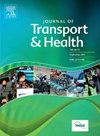Cycling infrastructure and transportational and recreational physical activity in Canadians
IF 3.2
3区 工程技术
Q2 PUBLIC, ENVIRONMENTAL & OCCUPATIONAL HEALTH
引用次数: 0
Abstract
Built environments that support cycling, especially those that are comfortable and safe (e.g., protected cycle tracks), are positively associated with physical activity (PA). The objective was to determine the associations between cycling infrastructure and transportational (PATRA) and recreational (PAREC) PA among urban-dwelling Canadians. Self-reported PATRA/PAREC data (N = 120,648, aged 12+ years) from the 2017, 2018, 2020 and 2021 cycles of the Canadian Community Health Survey were linked to cycling infrastructure. Neighbourhood-level infrastructure included: total kilometres (kmunweighted), kilometres weighted by comfort/safety (kmweighted), and category of infrastructure level. Multivariable logistic and linear regression examined the association between cycling infrastructure and engagement and duration of PATRA/PAREC. Approximately half (48.8 %) of urban-dwelling Canadians reported engaging in PATRA, while 58.2 % reported engaging in PAREC. Greater exposure to infrastructure was both associated with engagement in PATRA (kmunweighted: aOR = 1.04, kmweighted: aOR = 1.07, p < .0001) and PAREC (km: aOR = 1.02, kmweighted: aOR = 1.03, p < .0001), as well as duration of PATRA (km: β = 0.03, kmweighted: β = 0.06, p < .0001) and PAREC (km: β = 0.01, kmweighted: β = 0.02, p < .0001). Compared to the lowest level of infrastructure (category 1), the highest level (category 5) was associated with greater engagement and duration of PATRA (aOR = 1.88, 95 % CI: 1.69–2.09; β = 0.50, 95 % CI: 0.42–0.58) and PAREC (aOR = 1.26, 95 % CI: 1.13–1.39, β = 0.19, 95 % CI: 0.11–0.27). Cycling infrastructure, especially of higher comfort and safety, is associated with engagement and duration of PATRA and PAREC among urban-dwelling Canadians. Future longitudinal work is needed to explore associations with cycling-only outcomes, as well as identifying the actual cycling infrastructure used.
加拿大的自行车基础设施、交通和休闲体育活动
支持骑自行车的建成环境,特别是那些舒适和安全的环境(例如,受保护的自行车道),与身体活动呈正相关(PA)。目的是确定加拿大城市居民中自行车基础设施与交通(PATRA)和娱乐(PAREC) PA之间的关系。自报告的PATRA/PAREC数据(N = 120,648, 12岁以上)来自加拿大社区健康调查的2017、2018、2020和2021周期,与自行车基础设施有关。邻域基础设施包括:总公里数(公里加权)、舒适/安全加权公里数(公里加权)和基础设施等级类别。多变量逻辑回归和线性回归检验了骑行基础设施与PATRA/PAREC参与和持续时间之间的关系。大约一半(48.8%)的加拿大城市居民报告参与了PATRA,而58.2%的人报告参与了PAREC。更多地接触基础设施都与参与PATRA相关(kmunweighted: aOR = 1.04, kmweighted: aOR = 1.07, p <;0.0001)和PAREC (km: aOR = 1.02, kmweighted: aOR = 1.03, p <;.0001), PATRA持续时间(km: β = 0.03, kmweighted: β = 0.06, p <;。)和PAREC(公里:β= 0.01,kmweighted:β= 0.02,p & lt;。)。与最低水平的基础设施(第1类)相比,最高水平的基础设施(第5类)与PATRA的更大参与和持续时间相关(aOR = 1.88, 95% CI: 1.69-2.09;β= 0.50,95% CI: 0.42—-0.58)和PAREC(优势比= 1.26,95% CI: 1.13—-1.39,β= 0.19,95% CI: 0.11—-0.27)。在加拿大城市居民中,骑行基础设施,尤其是舒适性和安全性更高的骑行基础设施,与PATRA和PAREC的参与和持续时间有关。未来的纵向工作需要探索与仅骑自行车结果的联系,以及确定实际使用的自行车基础设施。
本文章由计算机程序翻译,如有差异,请以英文原文为准。
求助全文
约1分钟内获得全文
求助全文

 求助内容:
求助内容: 应助结果提醒方式:
应助结果提醒方式:


